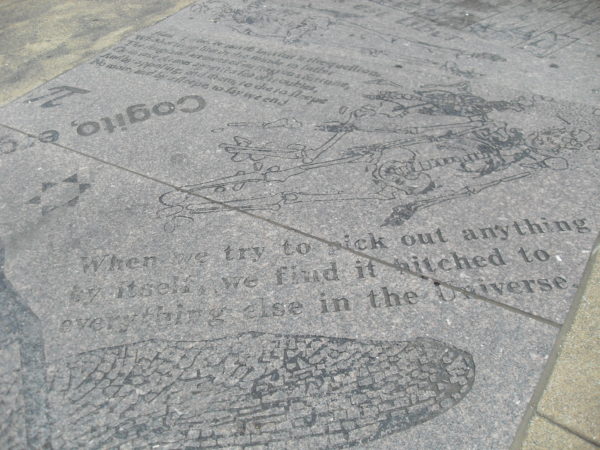
Outside Memphis Library
The Art of Eating a Pomegranate is really the title but to think of life, well—
When I was asked to give a keynote address at the donning of the stoles, I said yes, and shelved the task of preparing a speech, hoping that in good time, something profound would emerge.
You see, I am many things but mostly a poet, or rather, I enjoy knowing that on days when doubt assails the many hats I wear, poetry is always my assurance because with it and through its lens, I can be something and nothing all at once without conflict. When I’m nothing I find things to write about from that space of absolute freedom, and when I’m something, I again find things to chew on from a place of tangible weight. To say that I dwell in lightness and heaviness is my truth.
The night before the speech, I realized that I had been very busy with life. I did not stop to write the profound thing. What to say then? I could read a poem but I didn’t feel any juicy poem that would be right for the occasion. I’ve reached a point in my life when I do not do things just for the sake. I need to feel and love them deeply. In fact, I need to be 95-101% excited about doing anything for it to hold meaning. I am strange like that. This attitude is bringing me some enemies for sure, but also huge relief that I don’t have to waste anyone’s time or my own. While reflecting on his life, Mark Twain said, “There isn’t time, so brief is life, for bickerings, apologies, heartburnings, callings to account. There is only time for loving, and but an instant, so to speak, for that.” I believe him 100%.
Even in the absence of the profound speech, I was still 98% excited about the keynote, if only I could get it onto the page. For those schooled in the art of procrastination, you know that a break to the kitchen or bathroom is unavoidable. I went for a glass of water and happened to look in the direction of the two pomegranates in my fruit basket. Ta-da! The pomegranates, of course! I didn’t even have to write anything down. I went to bed happy. It wasn’t the revelation I had expected but it would do because it made sense to me. Hopefully, it would make sense to another as well—

who does not like dahlias?
The art of cutting a pomegranate and eating it. There are neat ways to do the job to avoid the mess. Otherwise, you end up staining your clothes, cutting through seeds, wasting the juice, and proving incompetent. On the other hand, that is all right—we learn by trial and error sometimes. We get better with time, acquired skill, and experience. We realize there’s an art and a poetic form to something as ordinary and everyday as cutting a pomegranate. We notice, of course, the metaphor extending into life itself—the mess, the bloodiness, the cleaning, and starting all over. What keeps us going is the immense sweetness to be tasted, the beauty and symmetry of the fruit, the inviting ripeness, the remembrance of the farmer who saw potential in the seed, planted and tended the garden so that in future the fruit could be enjoyed. The farmer saw sustenance and nourishment long before there ever was. The magic of that—a true miracle of creation and manifestation! Let us not forget that it took time, hope, intelligence, and love, before transforming into a tree, and then, life-giving fruit. Perhaps, there were dark moments when the farmer despaired if more leaves looked yellow instead of thriving green. Water, light, courage, and optimism, had to be involved in the survival of the tree, in my survival as a part of the ecosystem, in your survival too if you believe that you’re not separate from all things growing and dying.
And so, a sharp paring knife is a necessary part of the toolkit, a wooden spoon, a bowl into which you scoop the seeds, and a wiping cloth. It’s important to begin at the flowery top. You want to hold the knife at an angle and cut around the top to remove the cone—decapitate. Don’t get further down the body of the fruit or you’ll cut into the seeds. This is step one.
Step two: The pomegranate is not your most round fruit like an orange or grapefruit. It has ridges/ribs that run down the body, and these you’ll see more clearly after you’ve taken the top cone and pith out. Unlike humans who have 24 ribs making up 12 pairs, my pomegranates often have five or six solid sides. During his search for order in life and the divine universe, Johannes Kepler came up with laws of planetary motion by observing, among many things, the short and elegant composition of a snowflake, in comparison with honeycombs and pomegranates. The structures of these natural elements were as important as the planets in their elliptical orbits. The life of his mind took pleasure in studying geometric shapes and patterns. Kepler found distinctions in these elements’ efficiency to pack and expand their spheres, while completely filling the intermediate space and giving rise to geometric solids. But now, I’m on the verge of digressing. Back to the main topic at hand:
Ignore the flat sides/faces of the pomegranate and go for the ribs/ridges. Position your knife at your previous top cut and go down the ridge all the way to the bottom. Incision, to be precise. The point is to have less blood loss. Let the knife penetrate the red skin and white membrane without tearing into the seeds. About half an inch could be too deep.
Now comes the happy moment to crack open the fruit you’ve been waiting for. No need to lick fingers yet. Get a firm grip of this delicious thing, push your thumbs inside where the flower was. You’ve wounded it, the way now is softly into the red or pink, ever so gently. Pull apart decisively with all the tenderness you can muster. It will make beautiful sounds. The parts you’ve scored will separate along their natural borders.
Step four presents three choices. This is where you can get the wooden spoon, turn the rind face down into the bowl and hit it gently to release the juices and seeds. At this stage, if you’re like me, you’re salivating and eager to eat. Nourish the hunger a bit further? You may squeeze roughly with your hands to pop out the seeds. You may even lift the open segments to your mouth and suck in the seeds and liquid with your tongue. “If we live long enough,” Mark Nepo says, “life erodes us to a perfect opening.”

Memphis Lib
At the end, there will still be washing of hands, wiping the surface, looking in the mirror to make sure there’s nothing on your lips… but it will be quick and mostly enjoyable because of your skill and satisfaction—how you’ve handled the whole thing. How you’ve utilized the contents of your toolbox. Point is, everyone has got an individualized toolkit based on the knowledge and discipline undertaken. That’s why we have majors and minors. Specialization. The pomegranate is a delicate matter out there in the world, tough on the outside but softness inside. Tart and sweet. Multilayered, obviously. That is why you must approach it with the utmost care, love, and a sensuous intelligence. The more you attend to it, the easier it gets, the more fun and joy in the challenge. Practice gives you the ability to experiment with methods, innovate, and continue to imagine newer techniques. In the animal world, the pomegranate is a porcupine. Next time you see one, consider its regularity in the grand scheme of things. Your life could be changed!






No comments yet.